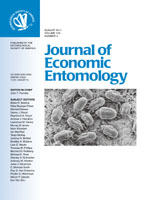Approximately US$1.3 billion is spent each year on insecticide applications in major row crops. Despite this significant economic importance, there are currently no widely established decision-support tools available to assess suitability of spray application conditions or of the predicted quality or performance of a given commercial insecticide applications. We conducted a field study, involving 14 commercial spray applications with either fixed wing airplane (N = 8) or ground rig (N = 6), and we used environmental variables as regression fits to obtained spray deposition (coverage in percentage). We showed that 1) ground rig applications provided higher spray deposition than aerial applications, 2) spray deposition was lowest in the bottom portion of the canopy, 3) increase in plant height reduced spray deposition, 4) wind speed increased spray deposition, and 5) higher ambient temperatures and dew point increased spray deposition. Potato psyllid, Bactericera cockerelli (Sulc) (Hemiptera: Triozidae), mortality increased asymptotically to ≈60% in response to abamectin spray depositions exceeding around 20%, whereas mortality of psyllid adults reached an asymptotic response ≈40% when lambda-cyhalothrin/thiamethoxam spray deposition exceeded 30%. A spray deposition support tool was developed ( http://pilcc.tamu.edu/) that may be used to make decisions regarding 1) when is the best time of day to conduct spray applications and 2) selecting which insecticide to spray based on expected spray deposition. The main conclusion from this analysis is that optimization of insecticide spray deposition should be considered a fundamental pillar of successful integrated pest management programs to increase efficiency of sprays (and therefore reduce production costs) and to reduce risk of resistance development in target pest populations.
How to translate text using browser tools
1 August 2011
A Decision-Support Tool to Predict Spray Deposition of Insecticides in Commercial Potato Fields and Its Implications for their Performance
Christian Nansen,
Kathy Vaughn,
Yingen Xue,
Charlie Rush,
Fekede Workneh,
John Goolsby,
Noel Troxclair,
Juan Anciso,
Ashley Gregory,
Daniel Holman,
Abby Hammond,
Erik Mirkov,
Pratyusha Tantravahi,
Xavier Martini
ACCESS THE FULL ARTICLE
It is not available for individual sale.
This article is only available to subscribers.
It is not available for individual sale.
It is not available for individual sale.

Journal of Economic Entomology
Vol. 104 • No. 4
August 2011
Vol. 104 • No. 4
August 2011
insecticide spraying
integrated pest management
potato psyllids
row crops
water-sensitive spray cards




